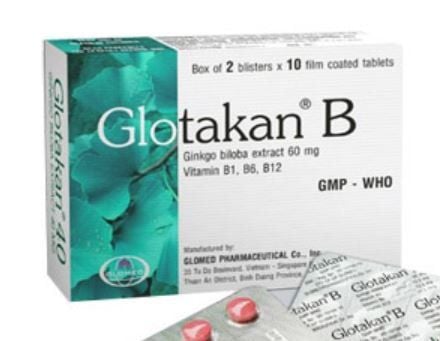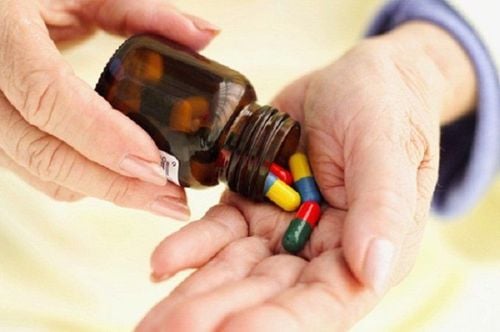This is an automatically translated article.
Orinadol is a product of Phuong Dong Pharmaceutical Joint Stock Company with the main ingredient being the active ingredient Naftidrofuryl. So what is Orinadol used for and how is it used?
1. What does Orinadol do?
The active ingredient Naftidrofuryl in Orinadol has 2 synergistic effects against disseminated ischemia.
At the vascular level: Naftidrofuryl is a specific antagonist of the 5-HT2 receptor of Serotonin, thereby counteracting its vasoconstrictor and platelet pre-aggregation activity; At the cellular level: Naftidrofuryl is an activator for the production of ATP, thereby enhancing cellular metabolism under ischemic conditions. Efficacy of Naftidrofuryl in clinical studies:
In stage II of peripheral artery disease, Naftidrofuryl significantly increased wheelchair walking distance when compared with placebo; In a study in patients with claudication, the use of Naftidrofuryl improved both the intensity and frequency of pain episodes during exertion, thereby helping patients perform daily activities. better. Pharmacokinetic characteristics of Naftidrofuryl:
Absorption: The active ingredient in Orinadol is rapidly absorbed from the intestine. Peak plasma concentrations are reached 2.5 hours after dosing; Distribution: The rate of Naftidrofuryl bound to plasma proteins is 80%, and this active substance can cross the blood-brain barrier and cross the placenta; Metabolism: Naftidrofuryl is metabolized primarily via hydrolysis to inactive metabolites; Elimination: 80% of Naftidrofuryl is excreted in the urine as conjugated metabolites. The half-life is about 3 to 4 hours.
2. Indications and contraindications of Orinadol
Orinadol is indicated in the following cases:
Symptomatic treatment of intermittent claudication of chronic arterial occlusion of the lower extremities stage II; Treatment of dementia or cognitive impairment (except Alzheimer's disease); It is recommended to support the treatment of sequelae of ischemic stroke; Support for treatment of Raynaud's syndrome Contraindications of Orinadol:
Patients with hypersensitivity to Naftidrofuryl or any other ingredient of Orinadol; The patient was found to have increased urinary oxalate; History of recurrent calcium kidney stones.
3. Dosage, how to use Orinadol
Orinadol is made in the form of film-coated tablets, so it is only for oral use. The right time to take Orinadol is during meals, and the patient should swallow the tablet whole with a large glass of water and do not chew or crush it.
Dosage of Orinadol 200mg specifically as follows:
Treatment of intermittent claudication in chronic obstructive lower extremity artery disease: 3 Orinadol tablets divided into 3 oral doses per day, equivalent to 600mg Naftidrofuryl oxalate; The remaining indications: 2 Orinadol tablets divided into 2 oral doses per day, equivalent to 400mg of Naftidrofuryl oxalate. Some notes on the dosage of Orinadol:
Treatment of intermittent claudication in chronic lower extremity artery occlusion with Orinadol only provides symptomatic relief and moderate improvement in walking distance within 6 months. Therefore, Orinadol should only be used as an adjunct to other therapies for the treatment of stage II chronic peripheral arterial disease (including cardiovascular risk factor control, regular exercise and stop smoking); Patients should be assessed for response to treatment with Orinadol after 6 months, then consider whether to continue taking the drug if the patient does not improve; Use of Orinadol in the elderly: Orinadol is mainly indicated for elderly patients, therefore, advanced age will not affect the pharmacokinetic properties of Naftidrofuryl, so no dose adjustment is necessary; Use of Orinadol in Children: This product is not indicated in children. Orinadol overdose and management:
Cases of Orinadol overdose may experience toxic manifestations such as decreased cardiac conduction, confusion and convulsions; Orinadol overdose treatment is mainly gastric lavage, activated charcoal (when necessary), close monitoring of cardiovascular function and symptomatic treatment if any; Patients with seizures can be controlled with Diazepam. Management of a missed dose of Orinadol:
If a dose of Orinadol is missed, the patient should take it as soon as possible. However, if it is almost time for your next dose to remember, skip the missed dose and still take your next dose of Orinadol at the scheduled time; Note: Do not double the recommended dose of Orinadol.
4. Orinadol side effects
During the use of Orinadol, patients may experience undesirable effects as follows:
Gastrointestinal disorders: Rare: Diarrhea, nausea, vomiting and epigastric pain; Frequency not determined: m Some cases of using Orinadol without drinking water before going to bed led to the pill getting stuck in the neck causing local esophagitis; Cases of oral mucosal ulcers due to Orinadol have also been reported; Renal and urinary disorders: Calcium oxalate kidney stones, skin and subcutaneous tissue disorders, rash; Hepatobiliary dysfunction: Orinadol may cause liver damage. Some very serious cases of acute hepatolytic effects have been reported.
5. Orinadol drug interactions
To date, drug interactions related to Naftidrofuryl have not been identified. Therefore, to avoid possible interactions when using Orinadol with other drugs, patients should inform their doctor or pharmacist of any preparations they are taking.
6. Notes when using Orinadol
The use of Orinadol can lead to changes in the composition of the urine and promote the formation of calcium oxalate kidney stones. The oxalate content in 1 Orinadol 200mg tablet is 38mg. Therefore, patients should drink enough fluids during treatment to maintain adequate urine output. Some patients who took Orinadol at bedtime without drinking enough water have reported local esophagitis side effects. Therefore, the drug instructions always require patients treated with Orinadol to take the drug with a large glass of water. Cases of use of Orinadol with severe liver injury of the acute cytolytic type have been reported. Therefore, in cases of suspected liver injury, transaminase levels should be checked promptly and Orinadol should be discontinued if symptoms suggestive of liver injury are accompanied by an increase in transaminase levels (even if only in adults). Moderate). Note that the active ingredient Naftidrofuryl is not an antihypertensive drug, so Orinadol should not be used to treat high blood pressure. Because Orinadol contains lactose, it is contraindicated in patients with congenital galactosemia, glucose-galactose malabsorption syndrome or in case of lactase deficiency. Naftidrofuryl does not affect the ability to drive or use machines, so this subject should use Orinadol if exactly indicated. Orinadol is indicated for use mainly in patients who are elderly and no longer able to become pregnant. Due to the lack of relevant clinical data, the use of Orinadol during pregnancy or lactation is not recommended.
Please dial HOTLINE for more information or register for an appointment HERE. Download MyVinmec app to make appointments faster and to manage your bookings easily.













